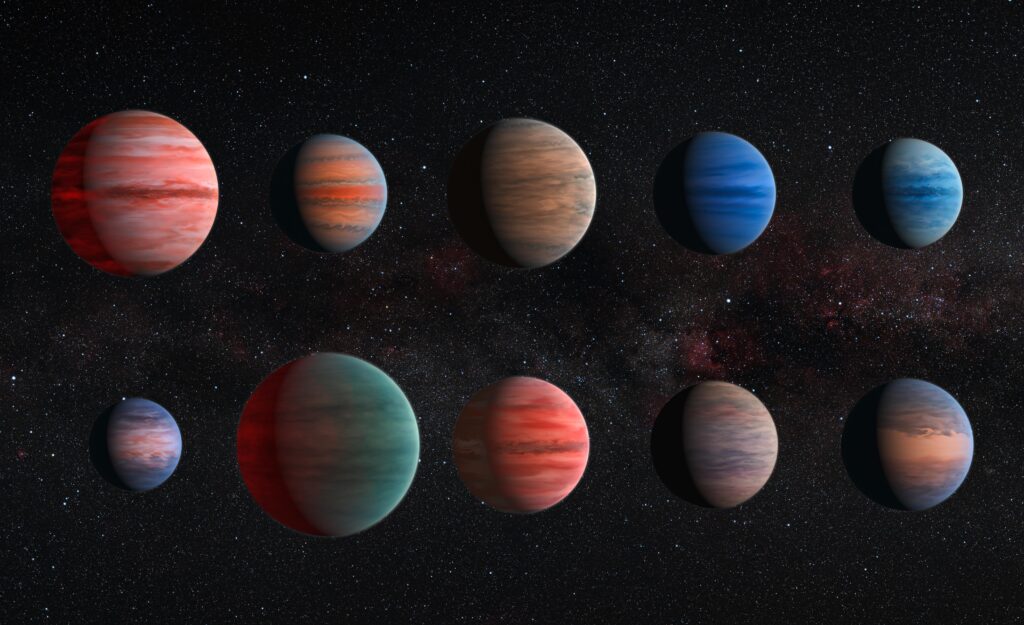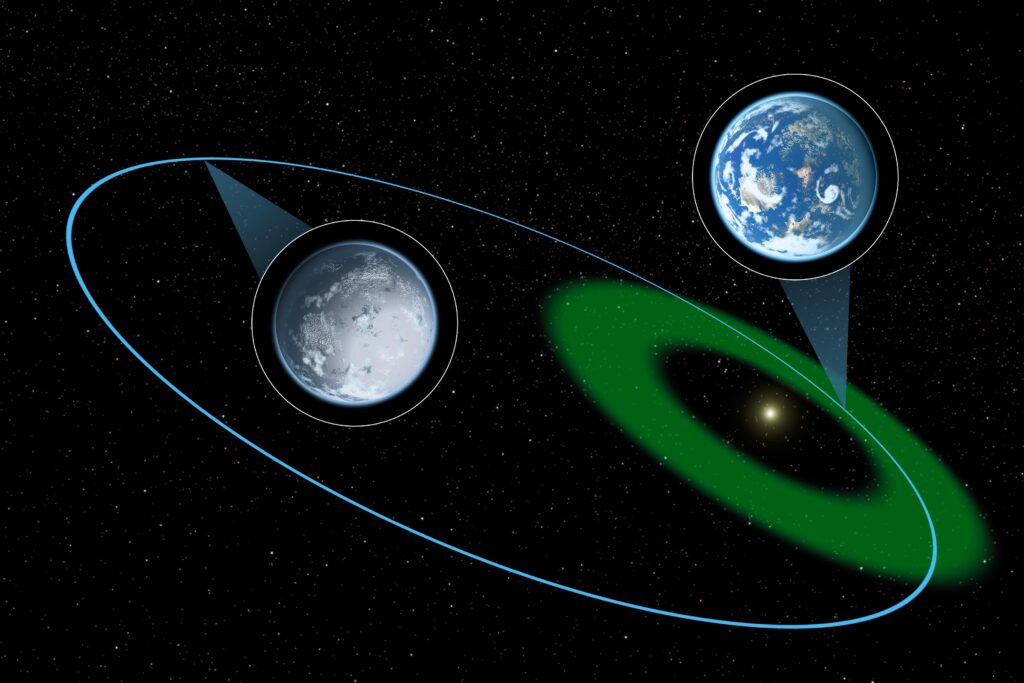Worlds Beyond Our Solar System
© NASA Goddard
Exoplanets, also known as extrasolar planets, are celestial bodies located outside our own solar system, typically orbiting stars other than the Sun. Over the past two decades, thousands have been identified, largely thanks to NASA’s Kepler Space Telescope. The first potential exoplanet sighting dates back to 1917, though it wasn’t officially classified as such at the time. The initial confirmed detection occurred in 1992. Another exoplanet, initially spotted in 1988, was officially confirmed in 2003. As of October 1, 2023, there are 5,506 verified exoplanets spread across 4,065 planetary systems, with 878 systems boasting more than one planet.
Detecting exoplanets is a challenging endeavor due to their faintness compared to the stars they orbit. Consequently, various methods have been developed to identify these distant celestial bodies. The most successful techniques include radial velocity, also known as Doppler spectroscopy, which tracks the motion of host stars influenced by the gravitational pull of their planets. Another method is transit photometry, which observes dips in starlight caused by exoplanets passing between their stars and telescopes.
Exoplanets exhibit a wide range of sizes and orbital patterns. Some are massive planets nestled close to their parent stars, while others vary from icy to rocky compositions. Scientists, particularly at NASA and other space agencies, are particularly interested in locating Earth-sized planets orbiting sun-like stars within the habitable zone.
The discovery of exoplanets has intensified our curiosity about the search for extraterrestrial life.
The habitable zone, often referred to as the “Goldilocks zone,” designates the range of distances from a star where a planet’s temperature permits the existence of liquid water—an essential ingredient for life as we know it. Although the earliest definition of this zone relied on thermal equilibrium, modern calculations consider additional factors, such as a planet’s atmospheric greenhouse effect, rendering the boundaries of the habitable zone somewhat ambiguous.
Rogue planets represent a distinct category of celestial objects that do not orbit any star. This group, particularly if composed of gas giants, is sometimes classified as sub-brown dwarfs. It is estimated that there may be billions or more of these rogue planets within the Milky Way galaxy.
METHODS OF DETECTION

Revealing the mysteries of exoplanets demands inventive methodologies and cutting-edge technology. Throughout the years, researchers have devised numerous approaches to identify and investigate these far-off celestial entities. Below are some of the key techniques utilized:
RADIAL VELOCITY METHOD
This groundbreaking technique relies on the gravitational tug-of-war between a star and its orbiting planet. As a planet orbits its host star, it causes the star to wobble slightly in response to the planet’s gravitational pull. This wobble induces shifts in the star’s spectral lines, which can be detected using high-precision spectrographs. By carefully measuring these shifts, astronomers can infer the presence of an exoplanet and even estimate its mass.
TRANSIT METHOD
Imagine witnessing a tiny eclipse in the vastness of space. The transit method capitalizes on this phenomenon. When an exoplanet passes directly in front of its host star from our line of sight, it temporarily dims the star’s light. This minuscule dip in brightness, known as a transit, provides crucial information about the exoplanet’s size, orbit, and atmosphere. Kepler and TESS are two prominent space telescopes that have employed this method with extraordinary success.
DIRECT IMAGING
Capturing the faint light of an exoplanet next to its brilliant host star is akin to finding a firefly next to a floodlight. Nevertheless, advancements in technology have made this endeavour possible. Specialized instruments and techniques, such as coronagraphs and starshades, block out the blinding light of the star, allowing astronomers to directly image exoplanets. This method provides valuable insights into their atmospheric composition and even potential signs of habitability.
MICROLENSING
In a cosmic ballet, the gravity of a foreground star can act like a lens, magnifying the light of a more distant background star. When a planet orbits the foreground star, it introduces additional lensing effects. By monitoring these subtle distortions in the background star’s light, astronomers can infer the presence of exoplanets, even those that might not be detectable by other methods.
ASTROMETRY
This method relies on precise measurements of a star’s position in the sky over time. The gravitational pull of an orbiting planet induces subtle changes in the star’s motion. By tracking these minute shifts, astronomers can infer the presence and characteristics of exoplanets.
DIVERSITY OF EXOPLANETS

Exoplanets, the celestial nomads of the cosmos, exhibit an astonishing diversity that stretches the bounds of our imagination. These distant worlds, orbiting stars beyond our Sun, come in an array of sizes, compositions, and environments, challenging our understanding of planetary systems.
GAS GIANTS
Behemoths akin to Jupiter and Saturn, these planets are predominantly composed of hydrogen and helium. They often orbit farther from their host stars.
Example: 51 Pegasi b was the first exoplanet discovered in 1995 and is a gas giant orbiting very close to its star. Discovered through the radial velocity method.
TERRESTRIAL WORLDS
These rocky exoplanets, akin to Earth, constitute a tantalizing category in the search for life beyond our solar system. Their solid surfaces and potential atmospheres make them intriguing candidates.
Example: Kepler-22b was one of the first Earth-sized exoplanets found in the habitable zone in 2011. Identified by the Kepler space telescope using the transit method.
ICE GIANTS
Resembling Uranus and Neptune in our solar system, these giants possess a higher proportion of “ices” like water, methane, and ammonia. They can occupy a wide range of orbits.
Example: OGLE-2005-BLG-390Lb is an ice giant found via microlensing in 2005. Detected through microlensing.
SUPER-EARTHS
Larger than Earth but smaller than Neptune, these exoplanets display a diverse range of compositions, from rocky to gaseous.
Example: Gliese 1214 b is a Super-Earth with a thick, water-rich atmosphere. Identified in 2009 using the transit method.
MINI-NEPTUNES
Similar in size to Neptune but potentially harbouring significant amounts of rock, these exoplanets showcase a broad spectrum of atmospheres.
Example: Gliese 1214 b is a mini-Neptune noted for its high water content. It orbits a small, red dwarf star known as Gliese 1214.
HOT JUPITERS
These massive gas giants orbit perilously close to their host stars, enduring extreme temperatures. Their existence challenges conventional theories of planetary formation.
Example: HD 209458 b is a hot Jupiter that gained fame for being one of the first exoplanets to have its atmosphere directly studied. It’s famous for its atmosphere’s escape and was discovered in 1999.
PHYSICAL PROPERTIES

Exoplanets, with their captivating diversity, exhibit a wide range of physical properties that set them apart from one another. Understanding these characteristics is crucial in unravelling the mysteries of these distant worlds.
SIZE AND MASS
Exoplanets vary greatly in size, from smaller than Earth to several times the size of Jupiter, and everything in between. Exoplanets come in various size categories, including terrestrial planets (rocky), super-Earths (larger than Earth but smaller than Neptune), and gas giants (predominantly composed of hydrogen and helium). Their mass is determined through methods like the radial velocity method, which measures the gravitational pull they exert on their host stars, causing them to wobble slightly.
DENSITY
Density is a critical parameter that provides insights into an exoplanet’s composition. Rocky planets, like Earth, tend to have higher densities due to their solid, compact structures. In contrast, gas giants like Jupiter have lower densities because they are predominantly composed of lighter gases.
The density of an exoplanet is determined by comparing its mass (calculated using methods like radial velocity) to its volume (inferred from its size or radius). This measurement helps scientists classify exoplanets into different categories, such as terrestrial (rocky), Super-Earth (larger than Earth but smaller than Neptune), or gas giant.
ATMOSPHERE
The atmosphere of an exoplanet holds significant sway over its overall climate and potential suitability for life. Variations are notable, ranging from dense, active atmospheres to those that are thin or absent altogether. The pioneering observation of an exoplanet’s atmosphere was made with HD 209458 b in 2001. By February 2014, scientists had scrutinized over fifty transiting exoplanet atmospheres, along with five directly imaged ones. This scrutiny led to the identification of molecular spectral traits, insights into day-night temperature shifts, and limitations on the vertical makeup of the atmosphere.
TEMPERATURE
An exoplanet’s temperature is greatly influenced by its distance from the host star and the type of star it orbits. Some exoplanets experience scorching temperatures due to their close proximity to their star, while others reside in frigid conditions at the outer edges of their systems. For instance, the exoplanet OGLE-2005-BLG-390Lb is estimated to have a surface temperature of approximately −220 °C (50 K).
It’s worth noting that these estimates may be subject to significant error, as they rely on factors like the planet’s often unknown albedo, and complexities introduced by phenomena such as the greenhouse effect. A handful of planets have had their temperatures gauged by observing the fluctuations in infrared radiation as the planet moves along its orbit and is temporarily obscured by its parent star.
ORBITAL CHARACTERISTICS
These include parameters like the semi-major axis (average distance from the star), orbital eccentricity (how elliptical the orbit is), and orbital period (how long it takes to complete one orbit). These properties provide insights into the exoplanet’s environment and potential habitability.
SEMI-MAJOR AXIS
This is the average distance between the exoplanet and its host star. It determines the amount of stellar energy received and plays a crucial role in a planet’s temperature and potential habitability.
ORBITAL ECCENTRICITY
This measures how elliptical, or non-circular, an orbit is. A lower eccentricity indicates a more circular orbit, while a higher value implies a more elongated path. This property affects the planet’s climate and seasonal variations.
ORBITAL PERIOD
This is the time it takes for an exoplanet to complete one orbit around its host star. It determines the length of a planet’s year and influences its climate and seasonal cycles.
OBLIQUITY
This is the angle between the exoplanet’s rotational axis and the perpendicular to its orbital plane. It affects the planet’s seasons and climate patterns.
ORBIT
This is the angle between the plane of the exoplanet’s orbit and the plane of the sky. It influences how we observe the planet’s transits across its host star.
SURFACE CONDITIONS
For rocky exoplanets, surface conditions depend on factors like the presence of liquid water, geological activity like volcanism, tectonic plate movements, seismic activity and the amount of radiation received from the host star and any potential protection provided by the planet’s magnetic field or atmosphere can shape the surface conditions and impact a planet’s habitability.
The physical features of a planet’s surface, such as mountains, valleys, oceans, and continents, influence its climate, and weather patterns. The chemical composition like the types and abundances of minerals, gases, and chemicals present on the surface can provide clues about the planet’s geological history and potential habitability.
MAGNETIC FIELD
If a planet possesses a magnetic field, it serves as a protective barrier, safeguarding its atmosphere against solar wind and cosmic radiation. This attribute is crucial for preserving an atmosphere over extended geological epochs. With sufficiently sensitive radio telescopes like LOFAR, it may be possible to detect the magnetic fields of exoplanets through their auroral radio emissions. These emissions could provide insights into the interior rotation rate of an exoplanet and potentially offer a more precise method for gauging rotation compared to cloud motion analysis.
AXIAL TILT
The axial tilt of an exoplanet refers to the angle between its rotational axis and an imaginary line perpendicular to its orbital plane around its host star. This tilt has significant implications for the planet’s climate and seasons.
A higher axial tilt can lead to more extreme seasonal variations, while a lower tilt results in milder, more consistent climates. Earth, for example, has a relatively small axial tilt of about 23.5 degrees, which contributes to its moderate and predictable seasons.
The axial tilt also affects the distribution of sunlight across a planet’s surface. It determines which areas receive more direct sunlight and experience warmer temperatures, and which areas receive indirect sunlight and experience cooler conditions.
HABITABILITY

The quest for habitable exoplanets is one of the most compelling endeavours in the study of these distant worlds. Habitability refers to the conditions that make a planet suitable for the existence and evolution of life as we know it.
THE GOLDILOCKS ZONE
Also known as the habitable zone, this region around a star is where conditions are just right for liquid water to exist on a planet’s surface. Water is a fundamental ingredient for life, and finding it in a liquid state significantly increases the potential for habitability.
STABLE CLIMATE
A habitable exoplanet is likely to have a stable climate with relatively mild temperature variations. Extreme and rapid temperature swings can make it challenging for life to thrive.
ATMOSPHERE COMPOSITION
An atmosphere with the right mix of gases, including oxygen and nitrogen, is crucial for habitability. These gases play roles in maintaining a stable climate and providing essential elements for life.
PROTECTION FROM HARMFUL RADIATION
A habitable exoplanet should have a magnetic field or other means of shielding its surface from harmful solar radiation and cosmic rays. This protection helps to safeguard potential life forms.
STABLE STELLAR ENVIRONMENT
The stability of the host star is vital. Frequent flares or intense radiation from the star can erode atmospheres and make habitability challenging.
GEOLOGICAL ACTIVITY
Volcanic activity and plate tectonics can contribute to habitability by regulating a planet’s climate and cycling nutrients through the crust.
LIQUID WATER
Liquid water is a universal solvent and a key medium for chemical reactions necessary for life. A habitable exoplanet should have sources of liquid water, whether in oceans, lakes, or underground reservoirs.
NUTRIENT AVAILABILITY
A diverse array of elements and compounds, including carbon, nitrogen, phosphorus, and others, are essential for life. Habitability hinges on the availability of these nutrients.
POTENTIAL FOR EVOLUTION
Habitability not only concerns the existence of life but also its potential to evolve and adapt to changing conditions over geological time scales.
In conclusion, exoplanets, or extrasolar planets, offer a captivating glimpse into the vast diversity of celestial bodies beyond our solar system. Since their discovery in 1995, they have revolutionized our understanding of the cosmos. With various detection methods, we’ve identified a range of exoplanet types, from terrestrial worlds to gas giants, some potentially harbouring conditions for life. The quest for habitable exoplanets, located within the “Goldilocks zone,” is a focal point, driving our curiosity and advancing astrobiology. As we explore their physical properties, orbital characteristics, and surface conditions, we edge closer to unravelling the mysteries of these distant worlds and the potential they hold for life beyond Earth.
